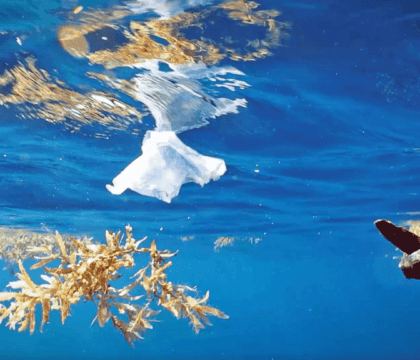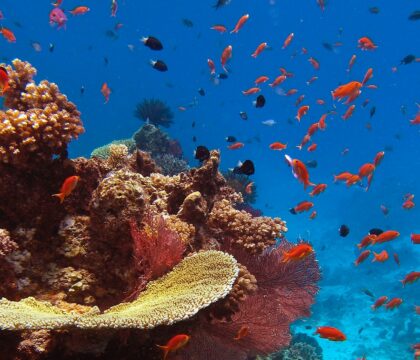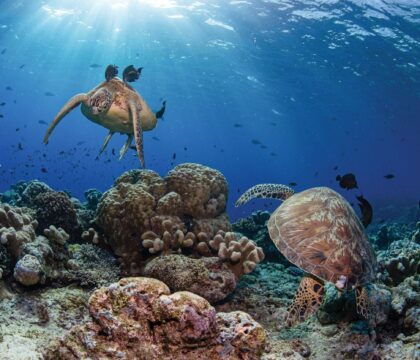March 30, 2022 • Travel Ideas
About 75 miles south of San Francisco, Santa Cruz is positioned on the northern coast of Monterey Bay, a globally important hotspot for ocean life that is home to 36 species of marine mammals, more than 180 species of seabirds, and hundreds of species of fishes and other marine life. While most people think they need to head all the way to Monterey, another 40 miles south along the coast, to see the wildlife of Monterey Bay, the reality is that whale watching from Santa Cruz offers similar opportunities with the added benefit of having less boat traffic than departures from Monterey. In this expert guide to whale watching from Santa Cruz, we discuss basic information about how to see whales and other wildlife from Santa Cruz, including answers to common questions like:
- Why are there so many whales in Monterey Bay?
- Where can I see whales in Santa Cruz?
- Can you see whales from shore in Santa Cruz?
- When can you see whales in Santa Cruz?
- What is the best month for whale watching?
- Are there orcas in Santa Cruz?
- When can you see blue whales in Santa Cruz?
An Intro to Whales and Wildlife in Monterey Bay
Monterey Bay is one of the premier locations in the world to view whales and other marine mammals. Although whales may be seen at any time of year, the springtime onset of wind-driven upwelling creates a large spike in food availability that attracts wildlife in large quantities.
Part of what makes Monterey Bay unique is the presence of deep submarine canyons below the water’s surface, in particular the Monterey Canyon, which is as deep as the Grand Canyon. These canyons act like upwelling “ramps” that help carry nutrients and organic compounds from very deep water nearer to the surface. Planktonic organisms thrive in these nutrient-rich conditions and this seasonal increase in life leads to incredible feeding conditions for whales from roughly April through November. Of course, whales are not the only species drawn to Monterey Bay’s nutrient rich waters. The upwelling attracts an impressive diversity of wildlife from across the food web, including apex predators like killer whales and great white sharks, as well as blue whales, the largest animals on Earth, several species of dolphins and porpoises, charismatic sea otters, seals, and sea lions, many seabird species, and much more.

Monterey Bay is one of the premier locations in the world to view whales. © Rhys Watkin
How to See Whales from Santa Cruz and Nearby
Being on the northern coast of Monterey Bay, Santa Cruz and its adjacent areas offer wonderful opportunities to see whales and other ocean wildlife that inhabit the Bay. But it is not quite as simple as heading out to the beach and looking out across the Pacific (although sometimes that works too!). Ideally, you should know when, where, and how to look for whales to maximize your chances. In the following sections we cover those important details, starting with the two main options you have for whale watching from Santa Cruz: 1) whale watching from shore, and 2) whale watching by boat.
Whale Watching From Shore Near Santa Cruz
It is possible to go whale watching from shore in and near Santa Cruz with a little bit of preparation and knowledge. To begin, while whales may be seen any time of year, your best chances to see whales from shore are during the annual gray whale migration, which takes place during the winter months of December – April. During this time, gray whales can be so numerous and so close to shore that it is possible to see many whales at once. Of course, it helps to have clear conditions and calm seas, as well as a good vantage point to look out across the water for whale blows (exhalations) and breaching whales. Some known spots for shore-based whale watching in/near Santa Cruz include West Cliff Drive, Wilder Ranch State Park, and Año Nuevo State Park. Año Nuevo State Park offers the added benefit of being home to Northern elephant seals, which can be seen year-round.

Wilder Ranch State Park north of Santa Cruz offers good vantage points to watch for whales from shore. © Amy Meredith, CC BY-ND 2.0
Whale Watching By Boat From Santa Cruz
If you are able, joining a whale watching boat trip from Santa Cruz is by far your best way to see whales, as well as many other species of marine wildlife that would be impossible to see from land, like leatherback sea turtles, Mola mola, and much more. Boat trips bring you out into the whales’ habitat, and give you the possibility to move around based on where the whales and other wildlife are congregating on a given day. On the water, you can witness whale behaviors like lunge feeding, spy hopping, and breaching, that make for an exciting experience. You also benefit by having a captain and crew that know the local waters, including where best to find whales, and have relationships with other vessels that share information about wildlife sightings each day.
Santa Cruz does not offer the same number of boat-based whale watching tours as Monterey, which is both good and bad. The bad = your choices and departure dates and times are more limited. The good = there is less boat traffic in the whale feeding grounds that are close to Santa Cruz.
Other important considerations have to do with the scope, length, and overall experience offered by each trip. The most common whale watching trips out of Santa Cruz last 3-4 hours and offer a good chance to see some whales (especially humpbacks) and other marine wildlife. These cruises tend to accommodate larger numbers of people, with as any as 60+ passengers per trip and are focused on spending a little time seeing whales before getting you back to shore.

Boat based whale watching not only gets you closer to the whales, but also provides a more educational experience. © Chris Biertuempfel
When Can You See Whales from Santa Cruz
Whales can be seen year-round from Santa Cruz, with some noteworthy seasonal differences. Humpback whales are the most common whale species found in Monterey Bay, and they are most abundant from April through November. In the winter months, from December to April, gray whales are the dominant species, as they make their annual migration by the thousands between southern breeding areas and northern feeding areas. Blue whales can also be seen in Monterey Bay, and are most prevalent during the summer months, as well as less common species like sperm, minke, and beaked whales.
Beyond whales, Monterey Bay is home to other resident marine animals that can be seen year-around, like California sea lions, harbor seals, sea otters, and several dolphin species, as well as seasonal inhabitants like northern elephant seals and leatherback turtles. The following list summarizes some of the most noteworthy wildlife viewing opportunities by season.
Year-Round Whales & Wildlife
- Whales
- Minke whale
- Dolphins
- Killer whales (orcas)
- Risso’s dolphins
- Common dolphins
- Northern right whale dolphins
- Pacific white-sided dolphins
- Bottlenose dolphins
- Porpoises
- Dall’s porpoises
- Harbor porpoises
- Pinnipeds
- Harbor seals
- California sea lions
- Other Marine Animals
- Southern sea otters

Southern sea otters are one of 36 marine mammal species that can be seen in Monterey Bay. They are found in the Bay year-round.
Seasonal Whales & Wildlife: March-May | Spring
- Whales
- Gray whales (including mother and calf pairs)
- Humpback whales
- Blue whales
- Pinnipeds
- Northern elephant seals

A gray whale mother and calf migrate along the California coast. These mother-calf pairs tend to stay close to the coast throughout their migration, and will be looking to avoid predators, especially killer whales and great white sharks. © NOAA
Seasonal Whales & Wildlife: June-August | Summer
- Whales
- Humpback whales
- Blue whales
- Fin whales
- Sperm whales
- Beaked whales
- Seabirds
- Sooty Shearwaters
- Black-footed Albatross

Blue whales, the largest animals on Earth, feed off the California coast in the summer and fall. © NOAA
Seasonal Whales & Wildlife: September – November | Fall
- Whales
- Humpback whales
- Blue whales
- Fin whales
- Sperm whales
- Beaked whales
- Pinnipeds
- Northern elephant seals
- Seabirds
- Sooty Shearwaters
- Black-footed Albatross
- Sea Turtles
- Leatherback sea turtles




